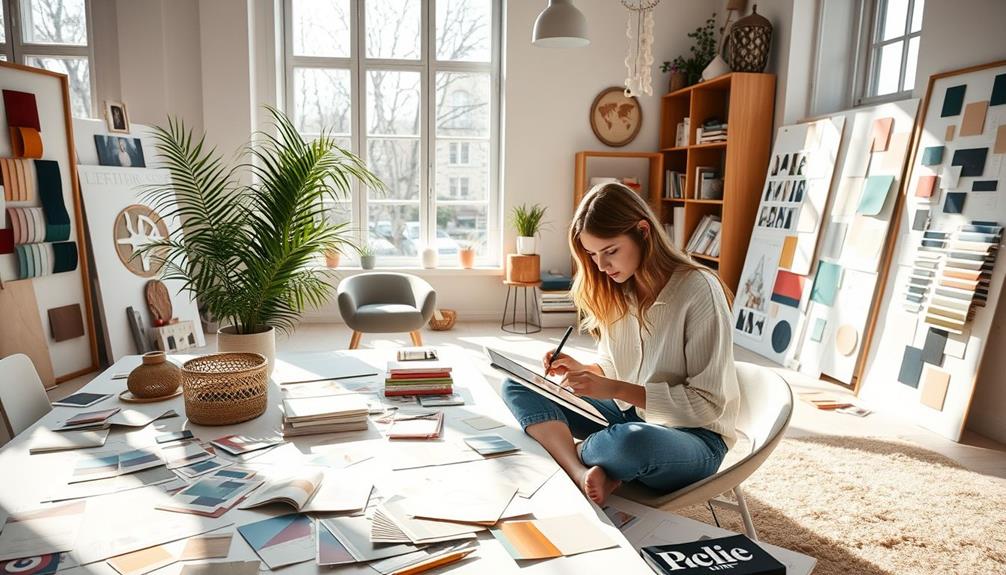To study interior design, start with an accredited degree that covers design theory, color palettes, and building codes. Combine classroom learning with real-world experience through internships, which help you apply your knowledge and build a strong portfolio. Networking is essential, so join professional organizations like ASID or IIDA to connect with industry experts. Don't forget to pursue certification, as it boosts your credibility. Regularly engage in workshops or online courses to stay updated on trends and materials. By following these steps, you'll lay a solid foundation for a successful career in interior design while discovering more about exciting opportunities ahead. Additionally, offering your services pro bono to friends, family, or non-profit organizations can provide valuable practical experience and help you sharpen your design skills. Providing free interior design advice to these clients can also help you build a positive reputation and gain valuable word-of-mouth referrals. Through continuous learning, networking, and hands-on practice, you can carve out a fulfilling and successful career in the dynamic field of interior design.
Key Takeaways
- Enroll in an accredited interior design program to gain foundational knowledge in design theory, color theory, drafting, and building codes.
- Complete internships to gain real-world experience and develop practical skills while networking with industry professionals.
- Build a strong professional portfolio showcasing a range of projects from initial sketches to final results to attract potential employers.
- Obtain certification through the NCIDQ exam and stay informed about state licensing requirements for career advancement opportunities.
- Engage in continuous learning through workshops, seminars, and online courses to enhance skills and maintain certification.
Understanding Interior Design
When you investigate understanding interior design, you'll find it's both an art and a science dedicated to enhancing interior spaces. This field combines creativity with practical knowledge, focusing on key elements like color, space, furniture, lighting, and texture. Each aspect plays a crucial role in creating functional and aesthetically pleasing environments tailored to specific client needs.
Understanding design theory and color theory is fundamental for your design career. These theories guide you in selecting palettes that evoke certain moods and drive functionality. Additionally, familiarity with building codes guarantees that your designs comply with legal requirements, making safety a priority.
As you explore deeper, recognize that different sectors—residential, commercial, hospitality, and healthcare—demand unique approaches. Staying updated on current trends, such as sustainability and smart technology integration, can elevate your designs and meet the growing demand for efficient spaces.
Ultimately, grasping the psychological impact of design helps you create spaces that people not only use but also enjoy. This understanding will set you apart as an aspiring interior designer, allowing you to make informed decisions that enhance the lives of those who inhabit the spaces you create.
Steps to Pursue Education

To successfully pursue education in interior design, you'll often want to start by choosing the right degree program. You can opt for an Associate's degree in Interior Design, which typically takes at least two years, or a Bachelor's degree, which usually spans four years.
Whichever path you choose, make sure the program is accredited by the Council for Interior Design Accreditation (CIDA) to enhance your job prospects.
Your coursework will cover essential topics, including design theory, color theory, drafting, and building codes, all vital for tackling real-world design challenges.
Engaging in internships during your studies will provide you with practical experience, allowing you to apply your knowledge in real settings. This experience is invaluable for building a professional portfolio, showcasing your skills to potential employers.
Importance of Internships

Internships are essential for gaining real-world experience in interior design, allowing you to apply what you've learned in class to actual projects.
They also offer valuable networking opportunities, helping you connect with industry professionals who can assist you in your career.
Engaging in internships not only enhances your skills but also opens doors to future job prospects.
Real-World Experience
Real-world experience is essential for aspiring interior designers, and internships play an important role in bridging the gap between theory and practice.
By participating in internships, you'll gain invaluable experience that enhances your design skills and prepares you for daily responsibilities in the field.
Here are four key benefits of internships in interior design:
- Application of Knowledge: You'll apply classroom theories to practical projects, solidifying your understanding of design principles and tools.
- Professional Portfolio Development: Completing projects during internships allows you to build a strong professional portfolio that showcases your design skills, making you more attractive to potential employers.
- Project Management Skills: Internships emphasize the importance of project management, helping you learn how to oversee projects from inception to completion efficiently.
- Clarification of Interests: Engaging in various projects helps you discover your design preferences, whether in residential, commercial, or specialized sectors like healthcare or sustainable design.
Networking Opportunities
Building a strong professional network is one of the most significant advantages of completing internships in interior design. Internships give you invaluable hands-on experience, allowing you to apply theoretical knowledge in real-world settings, which is vital for portfolio development.
By working in a design firm, you'll not only enhance your skills but also establish connections that can boost your career advancement. Engaging in internships helps you meet industry professionals who can offer mentorship and guidance.
With 75% of internships leading to full-time job offers, you can see how important these networking opportunities are in securing a position in the competitive field of interior design. Many design firms prioritize candidates with internship experience, recognizing it as a sign of initiative and familiarity with industry standards.
During your internship, you'll gain exposure to various aspects of the design process, including client interactions and project management, while also learning to use essential design software.
These experiences not only enrich your resume but also enhance your overall competency, setting you apart from other candidates. So, seize every internship opportunity—you'll be investing in your future as a professional interior designer.
Certification and Licensing

Achieving credibility in the field of interior design often hinges on obtaining the right certifications and licenses. To become a licensed interior designer, you usually need to pass the NCIDQ exam, which assesses your knowledge and skills. Here's what you should know about certification and licensing:
- Education and Work Experience: Before you can take the NCIDQ exam, you must have a degree in interior design and relevant work experience. This foundation is essential for your success.
- NCIDQ Exam Structure: The exam consists of three parts: the Interior Design Fundamentals Exam (IDFX), the Interior Design Professional Exam (IDPX), and the Practicum Exam (PRAC). Each part tests different competencies.
- State Licensing Requirements: These vary across states. Some require licensure for commercial projects, while residential work may not need certification. Always check your state's regulations.
- Continuing Education: Maintaining your certification often requires ongoing education. Many states mandate specific Continuing Education Units (CEUs) to guarantee you stay informed about industry standards.
Joining professional organizations like ASID or IIDA can also provide valuable resources for certification and networking opportunities.
Building a Professional Portfolio

Creating a compelling professional portfolio is essential for any aspiring interior designer, as it serves as a visual demonstration of your skills and creativity. A strong portfolio should showcase a variety of completed projects, highlighting your design process from initial sketches to final photographs. This not only illustrates your versatility but also your problem-solving capabilities.
Additionally, leveraging tools like the Études Architect App can enhance collaboration and streamline your project presentations, making your portfolio even more impactful.
When constructing your portfolio, include high-quality images and clear descriptions of each project. This helps potential clients understand your design approach and the thought behind your decisions. Tailor your portfolio to emphasize relevant work for specific job opportunities, ensuring that the showcased projects align with the interests and needs of prospective employers or clients.
Consider presenting your portfolio in both digital formats—like a personal website or PDF—and traditional flipbooks. This allows you to reach different audiences effectively. Engaging in pro bono work or community projects can also provide valuable experience and additional pieces for your portfolio. Not only does this showcase your commitment to design, but it also helps build your skill set.
Ultimately, a well-crafted professional portfolio is your ticket to standing out in a competitive field.
Networking and Professional Organizations

Networking is essential in the interior design field, as it opens doors to job opportunities and collaborations.
By joining professional organizations like ASID or IIDA, you gain access to valuable resources and connections with experienced designers.
Don't underestimate the power of workshops and events; they can greatly enhance your knowledge and help you build a supportive professional network.
Importance of Networking
Building connections in the interior design industry can greatly impact your career trajectory. Networking isn't just about exchanging business cards; it's about creating relationships that enhance your career prospects.
Joining professional organizations like ASID or IIDA opens the door to valuable networking opportunities. Here's why you should prioritize networking:
- Access to Mentorship: Connect with experienced designers who can guide you and help you navigate industry trends.
- Job Opportunities: Many positions are filled through referrals, so your connections can lead to potential job openings that aren't publicly advertised.
- Community Engagement: Participate in local chapter events and workshops to build your reputation and engage with the design community.
- Credibility and Expertise: Get involved in specialized associations to enhance your knowledge in niche areas, boosting your credibility in the market.
Professional Organizations Benefits
When you join professional organizations like ASID or IIDA, you instantly tap into a network of seasoned industry experts and fellow designers. These organizations provide invaluable networking opportunities that can greatly enhance your career.
By attending local chapter events, you engage with the community, share knowledge, and stay informed about the latest design trends.
One of the standout benefits is access to mentorship programs, where you can build relationships with experienced professionals who can guide you in your career.
Furthermore, many professional organizations offer continuing education units (CEUs), which are vital for maintaining certifications and keeping up with regulations in the ever-evolving design landscape.
You'll also find job boards and internship listings that can help you land your next position or gain essential experience.
Being part of a professional organization not only broadens your connections but also opens doors to resources that can elevate your skills and career prospects.
Continuous Learning Opportunities

Continuous learning is essential in the ever-evolving field of interior design. To stay relevant and enhance your skills, you should embrace various continuous education opportunities. Many states require ongoing education units (CEUs) to maintain your licensure, ensuring you're up-to-date with the latest trends and regulations.
Here are some valuable avenues for continuous learning:
- Workshops and Seminars: Attend these events to improve your design skills and learn about new materials, technologies, and sustainability practices.
- Professional Organizations: Join groups like the American Society of Interior Designers (ASID) or the International Interior Design Association (IIDA) to access resources, networking opportunities, and specialized education.
- Mentorship Programs: Engage with experienced designers to gain insights and practical knowledge that can greatly enhance your career development.
- Online Courses: Explore flexible learning options through online courses and webinars, allowing you to plunge into niche areas or advanced topics in interior design.
Career Pathways in Interior Design

Numerous pathways exist for those looking to build a career in interior design, each offering unique opportunities and challenges. A bachelor's degree in interior design typically takes four years to complete, while an associate's degree can be obtained in about two years for foundational skills in entry-level positions.
To advance in the design field, obtaining interior design certification through the National Council for Interior Design Qualification (NCIDQ) is vital. This requires a degree, relevant work experience, and passing a thorough exam.
While employment opportunities for interior designers are projected to decline by 5% from 2019 to 2029, proactive measures can keep you competitive. Networking and continuous professional development are essential in this evolving market.
Gaining experience through internships not only helps you build a strong portfolio but also showcases your skills and establishes credibility.
The average salary for interior designers in the U.S. was approximately $61,000 as of May 2019, with top earners in states like Rhode Island and California making over $70,000 annually.
Conclusion
In summary, diving into interior design might seem intimidating, but remember, every expert started as a beginner. By following the steps outlined, gaining hands-on experience through internships, and continually learning, you'll build the skills and confidence needed to thrive. Don't worry if you stumble along the way; it's all part of the journey. Embrace your passion and creativity, and you'll find joy in transforming spaces while crafting a fulfilling career in interior design.







